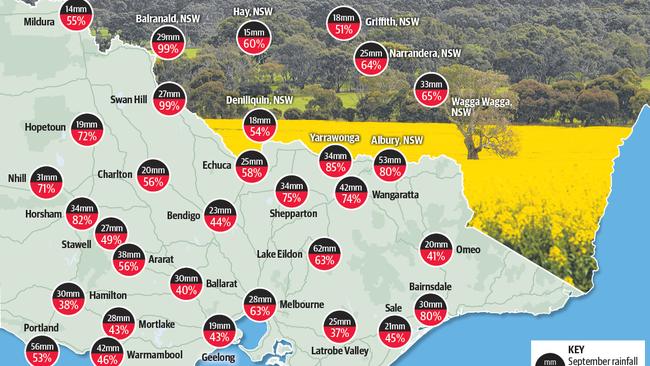Joshua Merrett, Steve Harrison: Hopes abound for October rain to finish ‘magic’ crops
All eyes are on the sky after a dry September challenged strong crops in the west and parched pastures in the east. See where the rain fell last month.
A dry September has challenged strong crops in the west of Victoria and parched pastures in the east, with all eyes now on this week’s forecast
Despite a drier than average September across much of the state, Victoria’s wheatbelt cropping regions are well positioned having avoided severe frosts and withstanding several hot spells.
Kaniva farmer and agronomist Joshua Merrett said if rain fell as forecasted this week, it would be timed perfectly.
“From Kaniva to Serviceton everything is still holding on. We are just hoping for that last rain to finish them off,” Mr Merrett said.
“The crops look magic. Depending where you look there is 10-25mm forecasted for this week and that would be great to finish it off.
“There is plenty of potential there. There was just enough subsoil moisture for most to get through the drier conditions, especially the hot, dry winds.”

Across northern and western Victoria September rainfall was slightly more favourable than the eastern parts of the state, albeit drier than average.
Swan Hill was one of very few areas to receive its monthly average rain during September, registering 27mm while Nhill (31mm) and Horsham (34mm) also received relatively strong falls.
However, central Victoria and several Gippsland regions are feeling the effects of a significantly drier start to spring than average.
In East Gippsland Bairnsdale (30mm) avoided the driest of the conditions, however, the Latrobe Valley (21mm), Sale (25mm) and Omeo (20mm) weren’t as fortunate.

Giffard West sheep producer Steve Harrison said farmers in his area had already destocked by about 10 per cent with this week’s potential rainfall key to future stocking and feed decisions.
“My neighbour had 19mm in September and 218mm across the year and we have had pretty much the same here,” Mr Harrison said.
“The district looks like it does on January 1 and those that have crops are green, but in need of a drink.
“Our lambing percentage has been historically high but that can be a curse during dry seasons.
“Most have some form of fodder, but it is wait and see what happens this week, things could change very quickly.”
The dry start to spring comes following the Bureau of Meteorology’s declaration of El Nino last month.
In their recently released climate outlook, the BOM forecasted national rainfall likely to be below median during October to December with maximum temperatures at least three times as likely to be unusually warm for most of Australia.





